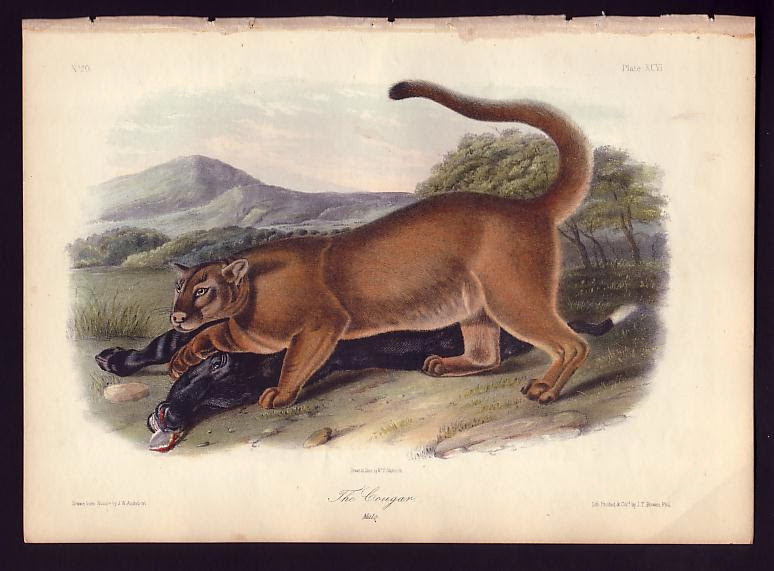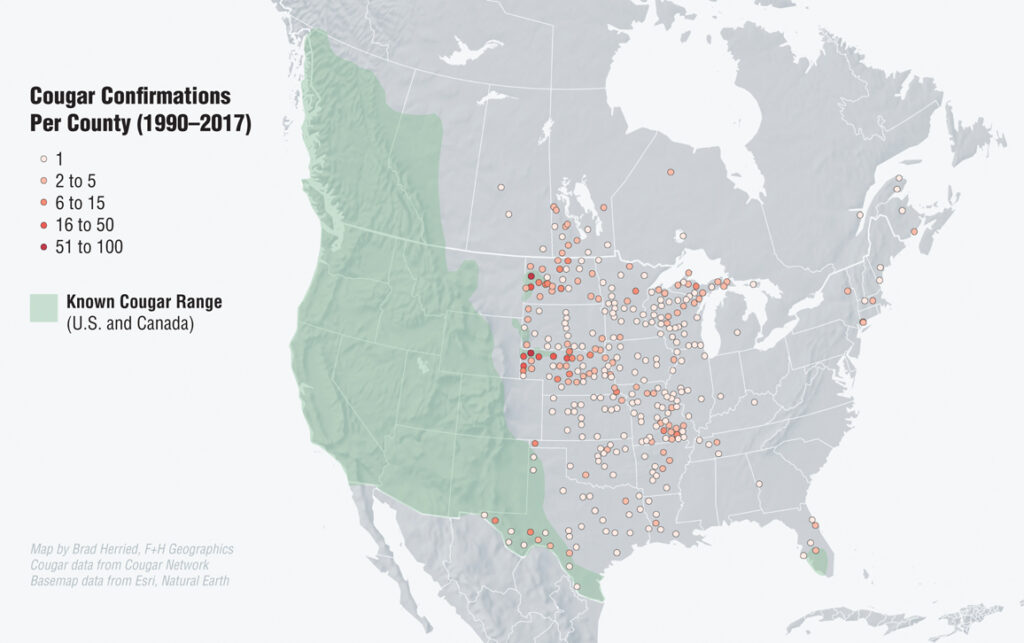
Over the past several weeks we have been getting reports of Cougar sightings from various people in our region and seen many of the social media posts. While we never say never, please understand that wildlife groups like ours and natural resource managers cannot just accept an account as fact without any hard evidence, something none of these reports have included. We don’t fault anyone for making a report, in fact, we encourage it. We also don’t blame anyone for not being able to identify a mysterious animal, even those of us who have spent our lives outdoors photographing and researching wildlife have mistaken a quick moving animal at night for something else. Sometimes those sightings remain inconclusive for the rest of our lives.
We know people are seeing something and we have no reason to believe anyone would make up any of these sightings we have heard about, but that doesn’t mean they are something as rare as a Cougar. The burden of proof is on those making the claims. We always recommend taking a photo or even better, a video of the animal with identifiable landscape elements so its movements, features, shape and scale might be analyzed. Nearly everyone has a camera in their pocket these days and trail cameras are present across most of our privately owned landscape where hunting occurs, so we should be able to get some sort of evidence with at least some of these sightings. Evidence can also include clear tracks with proper scale shown and fur samples that can be analyzed, at least to warrant more extensive investigation, but still may not be conclusive without a verifiable photo or video with identifiable landscape elements as hoaxes can occur with these methods. Please help prove the skeptics wrong with evidence if you truly believe you have seen an extinct species of big cat roaming the suburbs or local parks of Maryland.
Many don’t realize that just because Cougars are found in other parts of the country, and once did live here, that doesn’t mean they still occur here. Also the behavior and secretive nature of these animals must be considered when their sightings in highly developed areas are reported. Yes, there are cases like the famous P22 Cougar that was living in Los Angeles near the Hollywood sign but animals like that are still in areas with expansive mountain ranges and large, known populations of these cats and their signs are well documented. There are many avid outdoors people in the range of the Cougar in pristine habitat who will never see one in their lifetime and yet, according to social media accounts, many local residents here claim they see them all the time and it’s just a conspiracy that wildlife groups and agencies claim otherwise. Some even spread the urban legend that car insurance companies are releasing them to control deer populations, which is absurd. Please understand that a thriving population of Cougars here in the Mid-Atlantic would be one of the biggest finds of the century and likely the rediscovery of an extinct subspecies or extreme range extension of a Western species. This is a huge claim and not one that any of us would take lightly. Wildlife agencies have spent decades trying to save and restore the population of endangered Florida Panthers around the Everglades and the same would likely occur if the Eastern Cougar was rediscovered, but so far it has not. We would not be hiding their existence, we would celebrate it and do everything we could to save them, just like the work being done in North Carolina to bring back the Endangered Red Wolf.
Some of the reports of a large cat certainly could be a Bobcat, our last remaining wild cat in this region, though records of even that species are mostly anecdotal in our corner of Maryland, but we believe they still occur in our more wild stretches of habitat and certainly do in other portions of the state. These will have short tails which narrows down many sightings in one direction or another. To date, all of the records submitted to us of big cats with long tails have been large feral or outdoor roaming domestic cats with an unusual perspective that made them appear larger than they were. These mistaken identities are understandable for sure but other species like a Cougar easily eliminated based on body shape, coloration and size.
Here is a little more background-
While the Eastern Cougar, thought to be a subspecies of the Western Cougar (though some genetic work has shown it might have just been a distinct Eastern population), has recently been officially declared extinct after decades of being searched for and found to be absent from the United States since the 1930s, last recorded in Maine, it is interesting to look back at their story and the American ecosystem that once was. A taxidermied individual, one of the last known local specimens in the Mid-Atlantic that was shot around 1871 near Hawk Mountain in Berks County, has been on display at the State Museum of Pennsylvania. To our knowledge there has not been a confirmed wild cougar in our region since around that time.
Unnecessary fear and a lack of knowledge led to the relentless persecution of predators as our nation was growing. Wolves, cougars and bears were exterminated in massive numbers across the east for centuries. There were even bounties placed by governments to ensure their eradication. Many species ended up only hanging on in the Western states that had far less people and rugged terrain. Others remained in remote, relatively inaccessible places such as the Everglades as in the case of the Florida panther which has been left with a very small population of a few hundred animals thanks only to the Endangered Species Act with the hard work of conservation groups and government agencies making it possible. Even with all of that effort, around twenty or so animals in that small population are killed by automobiles alone each year. There was also logging and habitat destruction on a massive scale that coupled with past overhunting and loss of a favorite prey, the White-tailed Deer, ensured they could no longer survive.
Fast forward to today when many remote forests have regrown and the White-tailed Deer has rebounded to the point of over population in many areas thanks to focused restoration efforts, lack of natural predators and the creation of ideal habitat through our fragmented development practices. Other large mammals like the adaptable, omnivorous Black Bear have returned to a lot of their former range and are slowly expanding.
The Western Cougar or Mountain Lion, known to travel long distances, has begun to expand its range that was once restricted to the Rocky Mountains and west, is now being confirmed east of the Mississippi with greater frequency. So is it possible that any of these sightings could be a Western Cougar? Highly unlikely, but possible. For instance, one of these big cats, hit by a car and confirmed through genetic testing as a western individual, a young male born in South Dakota, showed up in multiple New England states before being killed in Connecticut. Other individuals may have traveled hundreds or even a thousand miles from where they were born in rare instances, but all known populations are currently still far to the west of us.

So if it’s possible, does that mean that sightings must be Cougars of some sort? While some will argue that Cougars, or Mountain Lions, have never left and reports have never ceased, we find that almost every single report we have seen is unverified, shows no physical evidence, or if photos or video does exist they can be easily proven as a Domestic Cat, Coyote, or Bobcat. The ones that are verified as Cougars have almost all been deemed hoaxes, usually with a photo taken somewhere out West being said to have been taken in the East, determined by searching for and matching the image online. Other rare but actually confirmed sightings outside of the known range can be traced to migrating or sometimes even escaped captive individuals thanks to DNA technology. So while rare sightings can occur, that doesn’t confirm the existence of the Eastern Cougar, which is the only explanation for a big cat that has always existed in this region, as many claim is the case. Those extremely rare wandering western individuals also don’t necessarily mean a new population will take hold. Even with food and habitat, they still need both sexes to be present and multiple individuals to ensure the health of that new population.
As scientific researchers and naturalists we have learned over the years that wildlife is full of surprises. In modern history a new Leopard Frog species has been discovered in highly populated areas (also found in parts of Maryland) and a new Coyote hybrid has populated our landscape in place of the wolves that once roamed in just the last fifty years. Just because something isn’t known to occur doesn’t mean it doesn’t exist or won’t some day in the future. Life tends to find a way to survive and doesn’t always follow the rules we set for them in our field guides and known research. That is why the natural sciences are ever evolving and growing. As skeptical as we may be of any rare or unusual sighting in our area, we will always gladly talk to anyone who saw something to help confirm or identify the species that was seen the best we can.
Now the big question, will a big cat like the Cougar ever once again roam the forests of the East as a permanent resident? If allowed to do so, from what we can tell, it isn’t a matter of if but when and where. Their prey has returned and much of the more remote areas that were deforested, have now grown back. They can travel large distances so recolonization is possible. We for one welcome a restoration of balance to the ecosystem, especially in our remote and less populated areas where as proven elsewhere in the country, large predators and humans can coexist in relative tranquility. Time will tell.

